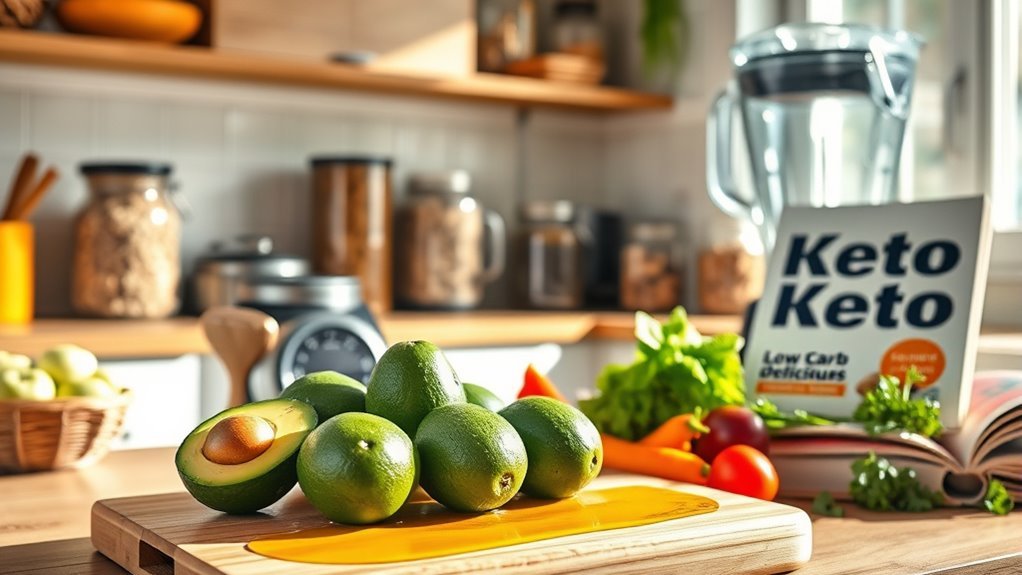To start with the keto diet, focus on reducing carbs and increasing healthy fats. Aim for quality sources like avocados, olive oil, and nuts while incorporating moderate protein from grass-fed meats and eggs. Prepare meals in advance and stock your kitchen with essential ingredients. Monitor your progress and stay accountable by connecting with others. It’s essential to navigate social situations thoughtfully too. There’s a lot more to explore about effective meal planning and overcoming challenges as you commence your keto journey.
Understanding the Ketogenic Diet

When you consider starting a ketogenic diet, it’s important to understand its fundamental principles. The keto basics involve greatly reducing carbohydrate intake while increasing fat consumption, prompting your body to enter ketosis—a metabolic state that utilizes fat for energy. However, dietary misconceptions often surround this approach; many believe it’s merely a high-fat diet without recognizing the quality and types of fats matter. Focusing on healthy fats from sources like avocados, nuts, and olive oil is essential. It’s also important to maintain moderate protein levels to guarantee your body stays in ketosis. By grasping these core concepts, you can navigate the keto landscape confidently, embracing the freedom to choose nourishing foods that support your health goals.
The Science Behind Ketosis

Understanding the science behind ketosis is essential for anyone starting on a ketogenic diet, as it reveals how your body shifts from using glucose to burning fat for fuel. In this metabolic state, your body undergoes fat adaptation, leading to increased ketone production. These ketones provide energy, enhancing your energy levels and supporting brain function. As your body adapts, you may experience significant ketosis benefits, such as improved insulin sensitivity and weight loss. Furthermore, hormonal changes from reduced carbohydrate intake can positively affect cardiovascular health. By embracing ketosis, you can access a powerful way to fuel your life, promoting both physical and mental freedom. Understanding these principles will empower you on your keto journey.
Foods to Embrace on Keto

As you commence your keto journey, knowing which foods to embrace can make a significant difference in your success. Focus on incorporating high-quality fats, such as avocados, olive oil, and nuts, which provide energy while keeping you satiated. Don’t forget about protein sources like grass-fed meats and eggs, which support muscle maintenance. For your veggie intake, choose low carb vegetables like spinach, kale, and zucchini, as they’re nutrient-dense and low in sugars. You can also enjoy keto friendly snacks like cheese, beef jerky, or nut butter to curb cravings without derailing your progress. By selecting these foods, you’ll nourish your body and enjoy the freedom to create delicious meals that align with your keto lifestyle.
Foods to Avoid on Keto
When starting a keto diet, it’s essential to avoid high-carb foods and sugary snacks that can derail your progress. These items can spike your insulin levels and hinder your body’s ability to enter ketosis. By steering clear of these foods, you’ll be better equipped to maintain a low-carb lifestyle and achieve your health goals.
High-Carb Foods
To successfully commence a ketogenic diet, you’ll need to steer clear of high-carb foods that can hinder your progress. High carb snacks, like chips, cookies, and granola bars, can quickly sabotage your efforts, as they’re often loaded with sugars and refined grains. Similarly, high carb meals, such as pasta, rice, and bread, can spike your insulin levels, pushing your body out of ketosis. Instead, focus on whole, nutrient-dense foods that promote fat-burning and energy stability. It’s all about making conscious choices—opt for low-carb vegetables, healthy fats, and quality proteins. By avoiding these high-carb options, you’ll create the freedom to embrace a lifestyle that supports your health and weight-loss goals while enjoying delicious, satisfying meals.
Sugary Snacks
While it might be tempting to indulge in sugary snacks, doing so can derail your ketogenic diet and hinder your progress toward ketosis. Sugary snacks are high in carbohydrates, which can spike your insulin levels and push your body out of fat-burning mode. Instead, consider sugar alternatives like stevia or erythritol, which can satisfy your sweet tooth without compromising your dietary goals. There are plenty of snack substitutes available, such as nuts, cheese crisps, or dark chocolate (with low sugar content) that can keep you satisfied while staying within your carb limits. By choosing these alternatives, you can enjoy the freedom of snacking without sacrificing your progress on the keto journey. Stay committed, and your cravings will lessen over time!
Meal Planning and Preparation Tips
When you’re starting a keto diet, effective meal planning and preparation can make a significant difference in your success. By focusing on essential keto ingredients, creating a weekly meal schedule, and implementing batch cooking strategies, you can simplify your routine while sticking to your dietary goals. These tips not only save time but also help guarantee you have delicious, compliant meals ready when you need them.
Essential Keto Ingredients
Starting your keto journey requires a solid foundation of essential ingredients that will not only support your meal planning but also make preparation easier. Stocking your kitchen with keto pantry staples and essential fats is vital. Here’s a quick guide:
| Keto Pantry Staples | Essential Fats | Protein Sources |
|---|---|---|
| Almond flour | Olive oil | Chicken |
| Coconut flour | Avocado oil | Grass-fed beef |
| Chia seeds | Coconut oil | Eggs |
Weekly Meal Schedule
Having the right ingredients on hand is just the beginning of your keto journey; effective meal planning is key to staying on track. Create a weekly meal schedule that emphasizes meal variety to keep your taste buds satisfied and prevent boredom. Plan your breakfasts, lunches, and dinners, ensuring they align with your keto goals. Don’t forget to include snack options; nuts, cheese, and low-carb veggies can help curb hunger between meals. Consider preparing your meals in advance to make your week easier and more enjoyable. By taking the time to organize your meals, you’ll empower yourself with the freedom to explore new recipes while sticking to your keto lifestyle. Remember, variety and planning can make a big difference in your success.
Batch Cooking Strategies
To make your keto journey more manageable, incorporating batch cooking into your meal prep routine can be a game changer. By preparing meals in advance, you save time and guarantee you always have keto-friendly options on hand. Here are some effective batch cooking strategies:
| Meal Type | Preparation Method | Storage Tips |
|---|---|---|
| Proteins | Grill or bake in bulk | Store in airtight containers |
| Vegetables | Roast or steam | Use vacuum-sealed bags |
| Sauces | Make large batches | Label and freeze |
| Snacks | Portion into servings | Keep in grab-and-go bags |
Common Challenges and How to Overcome Them
While beginning a keto diet can be an exciting journey, it often comes with its fair share of challenges that might test your resolve. One common hurdle is keto cravings, especially when your body adjusts to a low-carb lifestyle. To combat these, keep healthy, keto-friendly snacks on hand, like nuts or cheese, so you’re never left empty-handed.
Social situations can also be tricky, as you might encounter temptations or feel pressure to indulge. To navigate these, plan ahead—consider eating beforehand or suggesting restaurants with keto options. Remember, it’s about balance and enjoying your journey towards better health. By preparing for these challenges, you can maintain your commitment while still enjoying the freedom that comes with a keto lifestyle.
Tracking Your Progress
As you navigate the challenges of the keto diet, tracking your progress can provide motivation and help you stay on course. Utilizing keto apps can simplify progress tracking by logging weight measurements and body measurements. Food journaling is another effective method, allowing you to reflect on your meals and how they align with your goals. Set clear, achievable goals to keep you focused, and consider taking progress photos to visualize your transformation. Weekly check-ins can help you assess your journey and adjust your approach if needed. Monitoring health markers, like blood sugar levels, is essential too. Finally, having accountability partners can provide support and encouragement, making your keto experience more enjoyable and successful.
Tips for Sustaining Your Keto Lifestyle
Sustaining a keto lifestyle can be challenging, especially as you navigate social situations and cravings for high-carb foods. Here are some effective keto motivation strategies and social keto tips to help you stay on track:
| Strategy | Description |
|---|---|
| Meal Prep | Plan and prepare meals ahead of time. |
| Snack Smart | Keep keto-friendly snacks on hand. |
| Communicate | Inform friends and family about your diet. |
| Find Support | Join keto groups for accountability. |
| Stay Flexible | Allow occasional treats to avoid burnout. |


